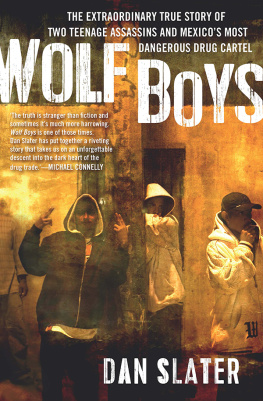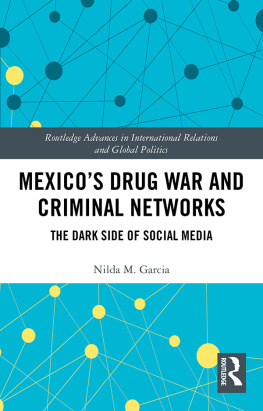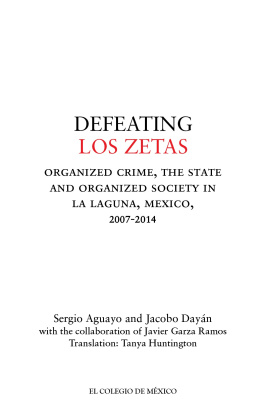The
Executioners Men
Los Zetas, Rogue Soldiers, Criminal Entrepreneurs, and the Shadow State They Created
George H. Grayson and Samuel Logan
With a new introduction liy George 11. Grayson
First published 2012 by Transaction Publishers
Published 2017 by Routledge
2 Park Square, Milton Park, Abingdon, Oxon OX14 4RN
711 Third Avenue, New York, NY 10017, USA
Routledge is an imprint of the Taylor & Francis Group, an informa business
New material this edition copyright 2015 by Taylor & Francis.
Copyright 2012 by Taylor & Francis.
All rights reserved. No part of this book may be reprinted or reproduced or utilised in any form or by any electronic, mechanical, or other means, now known or hereafter invented, including photocopying and recording, or in any information storage or retrieval system, without permission in writing from the publishers.
Notice:
Product or corporate names may be trademarks or registered trademarks, and are used only for identification and explanation without intent to infringe.
Library of Congress Catalog Number: 2011034932
Library of Congress Cataloging-in-Publication Data
Grayson, George W., 1938
The executioners men: Los Zetas, rogue soldiers, criminal entrepreneurs, and the shadow state they created / George W. Grayson and Samuel Logan.
p. cm.
Includes bibliographical references and index.
ISBN 978-1-4128-4617-2
1. Zetas Cartel. 2. Drug trafficMexico. 3. Organized crime-Mexico. 4. Narco-terrorismMexico. I. Logan, Samuel. II. Title.
HV5840.M4G727 2012
364.1060972dc23
2011034932
ISBN 13: 978-1-4128-5484-9 (pbk)
ISBN 13: 978-1-4128-4617-2 (hbk)
Dedication
We dedicate this book to the US law-enforcement community, and their Mexican allies, who are seeking to combat Los Zetas, the deadliest criminal organization based in the Americas. In addition, we will be forever in debt to our long-suffering loved ones without whose sacrifices and encouragement this volume would never have seen the light of day: Bryan Holt Grayson and Sams wife and children, Barbara, Iris, and Enzo.
Contents
List of Maps
List of Figures
List of Tables
The journey to bring this book to press involved the assistance of experts in security issues, drug Mafias, and the political, cultural, economic, and social contexts in which criminal organizations operate. Their help greatly benefited the authors attempt to unravel the layers of mystery that suffuse Los Zetas.
It is difficult to persuade anyone in Mexico, the United States, or Central America to talk openly and frankly about Los Zetas, much less speak at length about a group of men and women who incite unvarnished fear. As such, we are indebted to our friends and sources across the Americas who offered what information they could and enabled us to fill in the blanks left between various media stories, think tank reports, white papers, books, and other items in print that mentioned Los Zetas with some level of veracity.
Among those to whom we owe a debt of gratitude are Don Pollo Surez and his wife Margarita, Rubn Olmos, Alexander Renderos Vsquez, Steven Dudley of InSightCrime, Ildefonso Oritz of The Monitor (McAllen, Texas), Manuela, and a plethora of Mexican journalists, politicians, diplomats, and scholars, who, in the interest of their safety, will not be mentioned by name.
Law-enforcement officials on both sides of the border aided us enormously with off the record interviews. Many of these men and women risk their lives every day to combat Los Zetas and other venal criminal organizations.
We also thank Lorraine Jablonsky Floyd for research assistance.
Lindsey C. Nicolai, a College of William & Mary graduate, who is bound for law school, conducted research, prepared tables, tracked down maps, edited chapters, and provided ideas on shaping the text. For this reason, her name appears on the title page.
Lucinda H. Baker, associate director of Creative Services at the College of William & Mary, did a magnificent job of preparing a diagram of the Structure of Los Zetas.
Above all, gratitude is owed to Transaction Press and its distinguished publisher, Professor Louis Irving Horowitz. He and his superb colleagues consistently, enthusiastically, patiently, and astutely encouraged and supported our venture every step of the way.
With so many helping hands, we must attribute any errors of omission or commission to Hurricane Irene, who struck with a vengeance as we were completing the manuscript. No doubt, this vicious lady injected questionable entries that neither we nor the publisher discovered.
Map of Mexico
Source: Congressional Research Service, Mexico: Issues for Congress, by Clare Ribando Seelke, June 9, 2011. http://www.fas.org/sgp/crs/row/RL32724.pdf.
The United States maintains diplomatic relations with 194 independent nations. Of these, none is more important than Mexico in terms of trade, investment, tourism, natural resources, migration, energy, and security. In recent years, narco-violence has ravaged this cornucopia-shaped country with more than 65,000 drug-related murders since 2007 and some 26,000 men, women, and children missing. Los Zetas are the deadliest of the drug trafficking organizations (DTOs) on Mexicos criminal stage. The founders of this group, trained to combat the Gulf Cartel, deserted from Mexicos elite Airborne Special Forces Group in the late-1990s. Higher pay, better food, and the chance to profit from selling small amounts of cocaine enticed the thirty-one khaki-clad Benedict Arnolds to become a praetorian guard for Osiel Crdenas Guilln. He was the overlord of the Gulf Cartel based in Matamoros, Tamaulipas, across the Rio Grande from McAllen, Texas. The paranoid Crdenas acquired the nickname The Friend Killer because he ordered goons to pursue and execute real and imagined foes believed to be plotting his demise. Although the tough-as-nails Zetas formed protective circles around their boss, an informer revealed his whereabouts. This betrayal enabled the military to capture the kingpin on March 14, 2003.
After Crdenas imprisonment, a disoriented troika endeavored to control the reins of the Gulf Cartel. The ineffectiveness of the threesome prompted an attack from the Sinaloa Cartel, headed by the notorious Joaqun El Chapo Guzmn, who lusted for dominance over Nuevo Laredo, Matamoros, Reynosa, and other border cities that provided access to the United States.
In helping fend off the Sinaloan invaders, the diabolical Heriberto The Executioner Lazcano Lazcano emerged as the head honcho of Los Zetas. Yet, these villains, like a cadre of Frankensteins, gradually turned with a vengeance on their Gulf Cartel masterswith the final rupture occurring in the first half of 2010. Earlier they had entered situational pacts with the rival Beltrn Leyva Organization (BLO), former allies of the Sinaloa Cartel. Crdenas had never taught the paramilitaries the intricacies of the drug racket, and they had modest success importing cocaine from Colombia. Thus, they set out to brand themselves as the meanest, leanest, most ghastly underworld outfit in the Americas.












